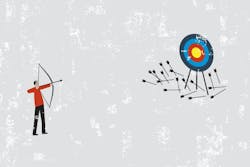Brad Kurth could no longer ignore the problems. Even though the body shop at Park Cities Ford in Dallas already had SOPs and he was confident in his staff of five bodymen and two helpers, Kurth says cars were consistently showing up to paint prep with errors or inconsistencies.
“In most places, the preppers for the paint shop are the most inexperienced people in the entire body shop,” says Kurth. “They have been trained to prep it one way, but when the product coming to them is inconsistent and adjustments need to be made, they don’t always know how to do it. This causes re-dos.”
Although Kurth says he would talk to the bodymen and try to narrow in on the problem, he soon found that not everyone completed repairs the same way.
That inconsistency is a common problem across many shops, says John Spoto, MSO key account manager at 3M.
“I always say, if you have SOPs in an establishment, then that should tell me that the consistency of the repair would be the same by every technician,” Spoto says. “Shops always agree with me on this. Then here’s my question: If the skill level of every technician is the same, then why can’t they all produce the same amount of hours?”
To promote more consistency in his shop, Kurth enlisted Spoto to help implement regular skills testing for staff. Spoto says it’s something that a shop can easily customize for their environment and can provide a starting point for training needs.
“I’m looking at a better overall quality repair and a more consistent repair for our preppers, which in turn is going to produce a more consistent prep job for the paint booth, which should increase our cycle time,” Kurth says.
Kurth, Spoto and Heath Harris, owner of Steve’s CARSTAR in Arnold, Mo., who has also implemented a similar process, discuss the steps to starting regular skills testing:
1. Start with Employee Self-Evaluations.
To start, have each employee complete an “employee skill self-evaluation.” Create a checklist for each department that lists all repair procedures and ask the technician to check the box pertaining to his or her skill level: Minor skill set, good skill set, excellent skill set.
For example, the technician self-evaluation form that Kurth and Spoto created lists procedures for structural area, body repair, paint prep area, paint finishing area and detail area. Try to be as specific as you can listing the procedures, as to get a feel for all areas of the repair process. Then, have employees sign and date the evaluation.
“It gives us an idea of where they think they are at,” says Harris. “If one guy doesn’t know how to do something and he doesn’t say anything, you’re never going to know. Because they’re not necessarily out there asking for help all of the time.”
Harris says he completed an evaluation for each technician, too, rating what he thought each staff member’s skill level was. While Harris plans to use the evaluations once for a baseline, Spoto says that shop owners could continue to administer evaluations on a yearly basis, for example, to keep a closer eye on skill levels.
Spoto also recommends that shop owners create a training schedule to stay on track. He suggests tackling one training for one repair process per month. Harris says his team worked on the training a little bit every day to get ready for the shop’s lean transition, while Kurth says he works on it on a weekly basis.
2. Conduct Pretests.
After the self-evaluation, put that skill level to the test by having employees complete pretests. Spoto has developed a two-part pretest for the shops he works with: a short (10-15 questions) multiple-choice test, and a hands-on process analysis.
Kurth says that his goal with the skills testing was to overhaul all of the shop’s SOPs, so he created pretests for each repair process. However, a shop can examine as few or as many processes as seems fit.
The pretest should contain questions pulled straight from your SOP. For example, a pretest on adhesive bonding might contain the question, “Which product should you avoid using when removing paint down to bare metal prior to bonding?” The goal of the pretest is to identify technicians’ understanding of the details, so creating more specific questions will lead to better insight.
After the pretest, ask each technician to walk you step-by-step through a process.
“For example, if you were going to repair this dent in a door that had four hours, walk me through your repair process,” Spoto says. “We have them write down specifically how they would make this repair.”
Kurth and Spoto did this for every step of the repair process, and collected the technician’s written procedures.
3. Gather the Results.
Kurth then created a spreadsheet for each repair procedure. Along the horizontal axis, he wrote each step of the process as described in the SOP. On the vertical axis, he listed each technician’s name and then checked off the steps described in their written process. Kurth says this gave him an easy view of the inconsistencies among technicians, and common steps that were missed.
“We put it in a spreadsheet and you can see what everyone is doing,” Spoto says. “Some of them are the same process and others aren’t.”
Kurth says that creating the spreadsheet with the results from the pre-test was an easy way to narrow in on the problem areas and figure out where to focus his training efforts.
“I identified the areas that I thought they needed the most work on and I will follow up and work with them on those areas of weakness,” he says.
Harris says that knowing the exact areas in which technicians need help has saved him time and money.
“If somebody doesn’t understand a certain process of our repair, that’s where we want to focus our training on, rather than just throwing them to I-CAR and letting them take classes that they might not really need help in,” he says.
4. Train to the Weaknesses.
Spoto says to start by going over the SOP and asking technicians if there are any changes that need to be made.
“We want to create consistency,” he says. “What do you think the right procedure should be? What do you think we should be doing? You don’t want to be demoralizing. It’s more about explaining why you would want to clean a panel before, for example, and how it affects the entire process.”
By going over the SOP with the technicians and asking for input, Kurth says the technicians feel more involved in the process and are more likely to contribute and buy into the new processes.
Besides reviewing the SOPs, he has also sent technicians to training, held classes at his shop and had the staff participate in webinars.
5. Administer a Post-Test.
After training, Spoto says to have the technicians take a post-test to re-test their skill level. Spoto says this test could be the same as the pretest, or cover the same points but contain different questions.
Spoto recommends making your way through every department in the shop, tackling one process a month with testing and training. After addressing a department, he also says to make it a point to revisit processes with pre-tests to ensure that the skill level has remained consistent.
For Harris, he says the skill testing was essential in helping his shop smoothly adopt lean principles.
“It’s one of the few things I’ve seen come into my shop and bring some real value,” he says. “You throw a lot of things against the wall and not a lot of it sticks. This one really seems to have some teeth to it.”
And while Kurth says he has always been a believer in education and training, implementing skills testing has helped him properly identify his training focus.
“It helped remove some gray areas and it gives the technicians an opportunity to have input, instead of cramming something down their throats,” he says. “The chances of them buying into our final product are better.”




